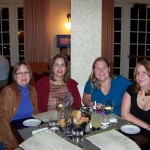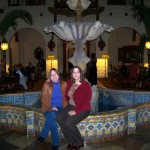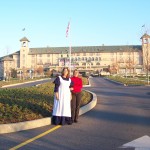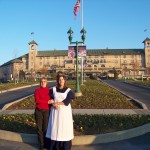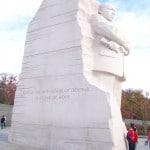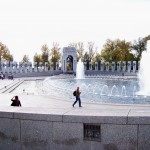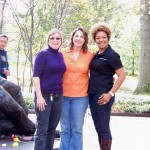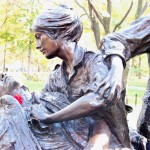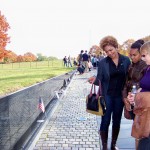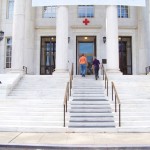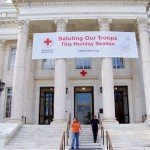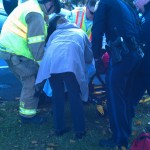by California Casualty | Nurses |
This Guest Blog post is by blogger Keith Carlson, RN, BSN. Nurse Keith, the blogger behind Digital Doorway, is the featured article in our Nurses’ News Resource: Nursing Pulse. To sign up to receive the Nursing Pulse in your inbox once a month, click here!
____________
Self-Renewal for Nurses: A Guest blog by blogger Keith Carlson
Spring is a time of year often associated with the theme of renewal in many cultures. Easter, Passover, Lent, Daylight Savings, the Equinox and other special cultural moments mark the increase in daylight, the flowering of the earth after the long, cold winter, as well as the general notions of rebirth and resurrection.
In the lives of most nurses, not much changes when winter turns to spring. For some, perhaps the commute becomes less icy and the snow gives way to grass (or mud!), but nothing much changes at the hospital, clinic or agency.
If a nurse is involved in home care, visits to patients’ homes may take on a different feeling as fireplaces become dormant and flowers begin to bloom, and these itinerant nurses may notice significantly less dangerous driving conditions as they shuttle between visits.
Outward signs in nature aside, the changes are actually few as winter turns to spring, so the nurse must find his or her own way of manifesting self-renewal at a time of year when change is in the air.
Physical Renewal
We all know the syndrome. Many of us gain weight over the course of the winter. In fact, some scientists hypothesize that human bodies naturally store fat in the winter based on ancient physiological adaptations in response to the potential for famine. So, as the weather warms, we put on our running shoes, grease up our bicycle chains, and otherwise reactivate our exercise routines.
Exercise is, of course, a great way to “wake up” your body, burn off some of that winter fat, and enjoy the outdoors.
Setting realistic goals for exercise is key to remaining optimistic and empowered in our exercise routines, so make sure you choose goals that are measurable, attainable and realistic. For instance, resolving to walk ninety minutes every day might be setting yourself up for disappointment and self-recrimination, but a goal of walking twenty minutes five days per week might be more attainable.
Food is another place where we can renew ourselves in the spring, especially as fresh, local produce becomes more available. At this time of year, we can make a conscious choice to “lighten up” our diets with more fresh fruits and vegetables, decreasing the intake of carbohydrates that we naturally crave during the colder months. Along with increased exercise, dietary changes help to increase our potential for weight loss, muscle strengthening and improved fitness.
Emotional, Psychological and Social Renewal
Emerging from the relative hibernation of winter, spring can make us feel like we’re bursting at the seams. Friends come out of hiding, we begin to feel a general sense of optimism, and we can feel drawn to come out of our wintry shells and embrace the world.
In Oriental Medicine, the winds of spring are often associated with the liver and the expression of anger, so some people can find early spring challenging on an emotional level.
In Southern France, a spring wind called “Le Mistral” is said to drive people mad, and those of us who live in the desert Southwest of the United States can also feel irritable as the spring winds blow the dusty soil and raise the risk of wildfires.
Meeting with friends, seeking short-term support from a therapist, coach or counselor, or requesting the counsel of a trusted member of the clergy can be helpful in times of transition. Engaging in a therapeutic relationship—whether brief or longer term–can sometimes be just the thing to move forward and galvanize personal growth.
Spiritual Renewal
I mentioned the counsel of a trusted member of the clergy in the previous section, and this can, of course, be one aspect of spiritual renewal.
For those of various faiths, spring brings renewal in the form of Easter’s celebration of the Resurrection, Passover’s acknowledgement of the Jews’ escape from imprisonment in Egypt, and “Al Hijra,” the Muslim New Year’s Day in April that celebrates Mohammed’s migration from Mecca to Medina. Pagan holidays and celebrations also abound in springtime.
Spiritual renewal can also be quite personal and non-denominational. Personally, increased time in nature brings me a sense of renewal and reconnection, with the budding of trees and the return of migratory birds signaling rebirth, change and promise.
Professional Renewal
Apart from the spiritual, physical, psychological and emotional aspects, we can also take a moment to reflect on the notion of professional renewal.
Whatever the season of the year, we’re always free to take stock of our careers, examine our goals, weigh our options, and decide if we’re still heading in a direction that feels growthful and satisfying.
Is your job indeed satisfying? Are you treated like a valuable asset or an expendable cog in a corporate wheel? Does your job feel more mechanical and routine than it used to? Are there professional skills you want to develop? Are there new opportunities to explore?
Questions such as these can spur an inward and outward examination of your career and professional life. Sometimes we can do this on our own, and at other times, a coach, therapist or trusted friend or colleague can assist us in sorting out the professional wheat from the chaff.
You might even decide that, every spring, you’ll take the time to polish up your resume, update your Linked In and social media profiles, and otherwise till the soil of your professional garden so that the ground is ready for the planting of new seeds of opportunity and change.
Spring Forward….and Carpe Diem
Truthfully, spring doesn’t really have to hold any meaning for you at all. In fact, the notion of spring’s renewal may just seem like an artificial construct to you.
Maybe spring is when your allergies are activated and you hole up in your bedroom with the air purifier on full blast as you escape the massive clouds of pollens that fill the air.
Or maybe spring is when you’re busy with your taxes and the last thing you want to do is examine your career or your spiritual standing.
You can find self-renewal at any time of year, and you can choose to seek support or enter a period of self-examination whether there’s snow on the ground or a lawn mower buzzing outside your window.
Self-renewal can occur as discrete events or as ongoing processes. Coaching, psychotherapy and other avenues of exploration are available year-round, but if the energy of spring speaks to you as a time for deeper introspection and personal action, you can certainly seize the day and delve as deeply as you like.
Remember that your life is your own, and the paths you choose to take are personal decisions. Nursing is a career that can bring much promise and professional satisfaction, as well as the possibility of disenchantment and disillusionment. Remain realistic about the course of your life, both personally and professionally, and use the tools and recruit the help that can help you navigate the hard times while celebrating the good.
We each have the opportunity to renew ourselves each day as we awaken from sleep and our feet hit the floor. How will you renew yourself today?
____________________________________________
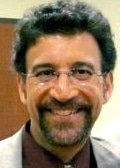 Keith Carlson, or Nurse Keith as he’s known to his blog community, has been in the nursing field since 1996. Keith runs a Nursing Blog called Digital Doorway. A Registered Nurse and Certified Professional Coach, Keith says he has equal passion for both, which he uses “to help nurses live the most healthy, balanced and satisfying lives possible.” When Keith isn’t busy nursing, coaching and blogging, he’s working on “RN.FM Radio: Nursing Unleashed.” Keith co-founded the station, which strives to be “a place where nursing thought leaders, entrepreneurs, writers, bloggers and gifted clinicians can make their voices heard.”
Keith Carlson, or Nurse Keith as he’s known to his blog community, has been in the nursing field since 1996. Keith runs a Nursing Blog called Digital Doorway. A Registered Nurse and Certified Professional Coach, Keith says he has equal passion for both, which he uses “to help nurses live the most healthy, balanced and satisfying lives possible.” When Keith isn’t busy nursing, coaching and blogging, he’s working on “RN.FM Radio: Nursing Unleashed.” Keith co-founded the station, which strives to be “a place where nursing thought leaders, entrepreneurs, writers, bloggers and gifted clinicians can make their voices heard.”
To check out Keith’s blog, click here. More information about his coaching can be found here.
To tune in to RN.FM Radio, click here.
To keep up with him on Facebook, click here.
You can find him on Twitter by clicking here!
Check out our Q& A with Nurse Keith, click here.
by California Casualty | Educators, Firefighters, Nominate a Hero, Nurses, Peace Officers |
Click here to cast your vote for February’s Hero of the Month!
Name: Jody W.
Profession: Registered Nurse (Home Health Nurse)
Nominated by: Stephen N.
In December 2011, Jody W. saved a complete stranger’s life. As a Nurse, this wasn’t really something new; saving lives is in the job description. But this time was different; this time Jody saved a man’s life by giving him her kidney. Growing up, Jody saw the struggle of kidney disease and the life-saving power of organ donation first hand. Her close family members battled kidney disease, and several were given a new lease on life through organ donations. In July 2011, Jody put herself on a donation transplant list as a non-directed donor. Not even 5 months later, she was cleared to donate and matched with a recipient. In December, moments before her surgery, Jody got to meet the recipient of her kidney and his family. He is now doing well and on December 8th, 2012, Jody and the recipient celebrated their 1-year transplant anniversary! Jody is also very dedicated to international health and has been on 13 mission trips in Central America. She says she plans to use any prize money from Nominate a Hero on her next trip to Honduras!
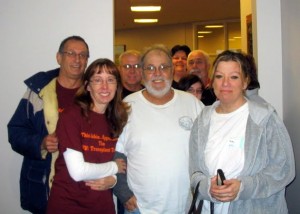
Jody, the recipient of her kidney, and their families on the day of the operation.
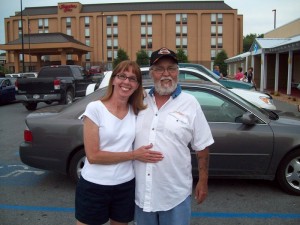
Jody and the recipient looking GREAT 6-months post-surgery!
Name: Keven R.
Profession: Sheriff’s Deputy
Nominated by: Joel H.
Deputy Keven R. was on patrol in Dallas when he happened to notice something peculiar: a car’s brake lights sticking out of a lake. He immediately drove down to the reservoir, pointed his patrol car’s headlights across the water’s surface and got out of his car. That’s when he realized that the car was slowly sinking- with two young women trapped inside. Deputy Keven R. immediately took off his utility belt and waded into the freezing water. He then swam to the car and shattered the car window’s glass. Inside, the two women were beating on the window, begging for help and telling him that they could not swim. He pulled both women out of the vehicle, ‘bear-hugging’ them as he swam them back to safety. Rowan barely got both women to shore before the car was completely submerged. Amazingly, the entire ordeal was captured on the Deputy’s patrol car dash cam. Check it out below:
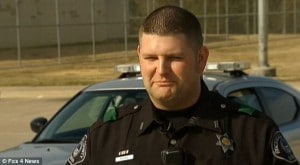
Deputy Keven Rowan
Name: Bradley H.
Profession: Volunteer Firefighter & EMT, Full-time EMT
Nominated by: Joyce H.
Brad got his start in firefighting as volunteer at only 18-years-old. Now, he serves as a full-time EMT while still volunteering his time as both an EMT and Firefighter. In March of 2011, Brad was called to a residential fire. When he arrived, there was already heavy smoke coming from the home. Recognizing the urgency of the situation, Brad and his team bravely entered the home–without gear–to rescue a bed-ridden woman trapped on the second floor. Within minutes, Brad and crew had the patient secured in an ambulance and on her way to the hospital. For his heroic action and quick-thinking, Brad was awarded the Medal of Valor.
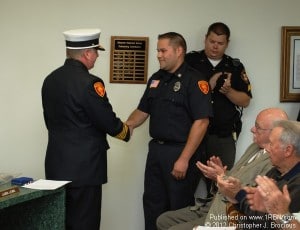
Brad H. receiving a Medal of Valor and Lifesaving from his Fire Chief.
Name: Mrs. Ridge
Profession: Educator
Nominated by: Vicky P., Debra P., Ginny B., and Zena B. (Parents of current and previous students)
Parents of Mrs. Ridge’s students simply cannot say enough about the impact this inspiring educator has on their children, both academically and personally. They note her ‘incredible spirit, kindness, generosity and excellence as a teacher and citizen.’ Comparing her teaching abilities to being ‘able to leap tall building in a single bound,’ they shared all the ways her dedication and innovation has inspired their children to develop a love for learning. Mrs. Ridge is known for the family-like atmosphere she fosters in her classroom and unique ability to tailor a lesson plan to a diverse group of students by truly getting to know each of her students. She has also been known to dip into her own pocket to make sure she can give her students the very best despite budget cuts in her school district, even going so far as to provide lunches for students that would otherwise go without and donating used clothes from her own home to her students’ families. This educator is truly viewed as a ‘hero’ and ‘angel’ by her students and their families.
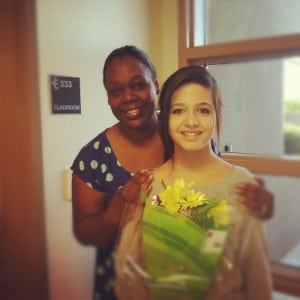
Mrs. Ridge and a former student
by California Casualty | Nurses |
This Guest Blog post is by blogger Keith Carlson, RN, BSN. Nurse Keith, the blogger behind Digital Doorway, is the featured article in our Nurses’ News Resource: Nursing Pulse. To sign up to receive the Nursing Pulse in your inbox once a month, click here!
____________
Nursing Amidst the Holidays: A Guest blog by blogger Keith Carlson
At this time of year, most people feel the added stress and joy of the holiday season, and nurses are certainly no exception in this regard. Beginning with Thanksgiving, the pressures and expectations begin to mount exponentially, and although there’s often a great deal to celebrate and express gratitude for, some of us can feel like we’re pushed to our limits as we navigate the waters (and snows!) of the season.
Diagnosis: Alteration in Holiday Spirit
If you work in a hospital, there are most likely Christmas decorations everywhere, and other holidays—like Hannukah and Kwaanza, may also be recognized and honored.
Meanwhile, your patients may be forlorn and lonely as they spend the holidays in the hospital, and part of your unofficial nursing duties may be adding “Alteration in Holiday Spirit” to their care plan (along with interventions to assuage their suffering and sadness).
If you’re a homecare nurse, you have the honor and responsibility of visiting patients in their own homes. This type of nursing brings with it various challenges at this time of year, including patients who have no family or are too poor or ill to fully enjoy the holiday season.
Nurses employed in nursing homes and long-term care facilities also face the potential sadness and isolation of their patients, and witnessing residents’ sadness and loneliness can be a psychic burden for the sensitive nurse.
What About Your Spirit?
While you strive to lift the spirits of your patients—whether in the hospital, nursing home, or other milieu—there’s someone who should also be on your list of those in need of support: yourself! This time of year can be difficult enough without potentially carrying the burden of your patients’ loss and grief, and making sure you pay enough attention to your own needs is paramount.
In some workplaces, the high energy of the holiday season can feel very uplifting and cheerful, with office parties, gifts, cards and special treats that brighten one’s day and add a special something to the functions that still need to be accomplished.
However, if the demands of your workplace are generally intense, you may experience a variety of emotional reactions to the “cheer” being spread by the seasonal festivities, and these reactions and feelings are altogether normal.
Keeping yourself balanced and functioning at your best during this time of year is important, so recognizing how you feel and what your individual needs are is something worth paying attention to, whether those needs are emotional, physical or spiritual in nature.
Holiday Self Care for the Nurse
If the stress of the holiday season is impacting you at work or at home, there are ways to “dial down” the stressors so that you prevent illness, overwhelm and burnout.
First, you must pay close attention to the basic aspects of your self-care, and while these are universal at any time of year, they are even more important now.
Nutrition
Sweets and treats abound at holiday time, but overindulgence can lead to a suppressed immune system, gastrointestinal disturbances, weight gain, nutritional deficiencies, and feelings of lethargy and brain fog.
There are temptations around every corner at this time of year, and avoiding (or limiting) your intake of cookies, cakes, candy, alcohol and other special foods may help you to feel better, even though it’s hard to resist when they’re right under your nose.
If you have a friend or colleague who also wants to resist temptation, enlist one another as “accountability partners” and find ways to provide mutual support. Bringing alternative healthy treats to work can help, as well as collaborating on methods for avoiding the nutritional pitfalls that feel good in the moment but come back to haunt you later.
Hydration
Staying hydrated is always important for every physiological function you can think of. Regularly filling your belly with good quality water can also suppress your appetite when faced with those delectable but nutritionally poor treats that seem to be on every desk and nurses station throughout December. Skip the coffee, soda and sugary eggnog and choose water instead! Your brain and other organs will thank you.
Rest and Sleep
You may laugh, but getting enough sleep and rest is not just important, it’s crucial. The quality and quantity of your sleep impacts your ability to maintain or lose weight, function at your best, and keep an even emotional keel as the stressors increase. If you find yourself staying up too late and getting up too early (or waking up in the middle of the night to ruminate over your shopping lists , then you have to take action to get your sleep on track—stat!
Exercise
This may seem like a joke to many of us, but getting exercise is important in every season, but it’s probably true that the majority of people slack off on their exercise routines during the winter, especially as the holidays approach.
If, like me, you live in a climate where it begins to get cold in November, your summertime exercise regimen may not translate well in winter. Some of us find ourselves confused and stultified as to what to do to stay fit during the colder months, so getting a handle on this can be very important for your health and ability to resist stress and illness.
Your Emotional Well-Being
I mentioned your spirit earlier in this article, and I want to reiterate again how important it is that you pay attention to your own emotional and spiritual needs during the holiday season.
With the recent tragedy in Newtown, Connecticut, many of us are feeling grateful for the safety of our families and friends. However, the holidays can also bring up our losses, our grief, and the people who we miss and are no longer with us. Pay close heed to how you’re feeling, and reach out for help and support if you need it. Support can come from friends, mental health professionals, clergy, an Employee Assistance Program at work, or family members.
Remember, your mental and spiritual well-being are important, and if you’re feeling balanced and healthy mentally, emotionally and spiritually, it allows you to be a more effective nurse and caregiver.
Have Fun and Give Thanks
Of course, the holidays can be stressful, but they can also be joyous and celebratory. One way to care for yourself is to make sure you have time and energy for fun, for family and friends, and for giving thanks for all of the blessings in your life.
We nurses often think of others before we think of ourselves, but being a martyr doesn’t serve you or the people you care about. A nurse who practices good self-care sets an example for others around her, so be the one to set the example by paying attention to your own needs. It’s like they tell you on any airplane before the pilot takes the plane into the sky: you need to put on your own oxygen mask before you help someone with theirs. The same applies to caring for your own needs at work and at home.
Go ahead: nurture yourself, pamper yourself, and make this holiday season one that’s healthy, vibrant and balanced. You deserve it.
________________________
 Keith Carlson, or Nurse Keith as he’s known to his blog community, has been in the nursing field since 1996. Keith runs a Nursing Blog called Digital Doorway. A Registered Nurse and Certified Professional Coach, Keith says he has equal passion for both, which he uses “to help nurses live the most healthy, balanced and satisfying lives possible.” When Keith isn’t busy nursing, coaching and blogging, he’s working on “RN.FM Radio: Nursing Unleashed.” Keith co-founded the station, which strives to be “a place where nursing thought leaders, entrepreneurs, writers, bloggers and gifted clinicians can make their voices heard.”
Keith Carlson, or Nurse Keith as he’s known to his blog community, has been in the nursing field since 1996. Keith runs a Nursing Blog called Digital Doorway. A Registered Nurse and Certified Professional Coach, Keith says he has equal passion for both, which he uses “to help nurses live the most healthy, balanced and satisfying lives possible.” When Keith isn’t busy nursing, coaching and blogging, he’s working on “RN.FM Radio: Nursing Unleashed.” Keith co-founded the station, which strives to be “a place where nursing thought leaders, entrepreneurs, writers, bloggers and gifted clinicians can make their voices heard.”
To check out Keith’s blog, click here. More information about his coaching can be found here.
To tune in to RN.FM Radio, click here.
To keep up with him on Facebook, click here.
You can find him on Twitter by clicking here!
Check out our Q& A with Nurse Keith, click here.
by California Casualty | Educators, Firefighters, Nominate a Hero, Nurses |
Nominate Your Hero Here!
Congrats to Mark R – our Hero of the Month for December. You can read every finalist’s story below!
Name: Scott D.
Profession: Registered Nurse
Nominated by: Barbara S.
Described as an inspiration to all who know him, Scott is a Registered Nurse working as a home visitor with a hospice unit. Before going into nursing, Scott saved lives as a combat engineer & infantryman with the US Army, jump master, parachute trainer, rescue scuba diver and former Fire Chief. Scott also frequently volunteers to work with the homeless, buying them food and helping them find services and resources. He has also worked with the Veterans Association, attending military funerals and visiting homebound veterans. In his role as a hospice nurse, Scott often brings his beloved dogs with him on home visits. He even volunteered to adopt a veteran’s dog when the owner moved into an assisted living facility. Scott’s nominator, Barbara, describes him as ‘a true hero to his neighbors and friends’ who ‘has been there to help when no one else stepped up.’
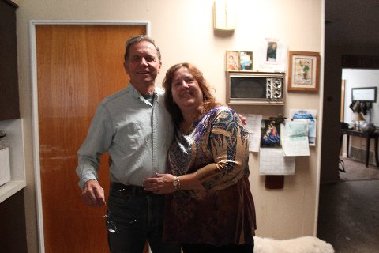 Scott D. and his nominator, Barbara
Scott D. and his nominator, Barbara
Name: Mark R.
Profession: Firefighter & EMT
Nominated by: Jessica M., a former patient
Mark and Jessica met under the worst of circumstances. A driver crashed into a car carrying Jessica and her daughter, Kendra, on a backwoods rural road. Mark and his team responded to the scene. As responders worked on freeing Jessica from the vehicle, she remembers Mark crawling into the car beside her, assessing her medical state and updating her on Kendra’s condition. “He not only took care of me that day, he held my hand, made me human not just a patient,” remembers Jessica. Following the accident, Mark traveled to check on Jessica’s daughter after she underwent brain surgery. Even now, Mark continues to keep tabs on Kendra, responding whenever she has a medical emergency, even if he’s off-duty, and organizing fellow firefighters to help build a wheelchair ramp for her home. Seven years after their fateful meeting, the three remain close friends.
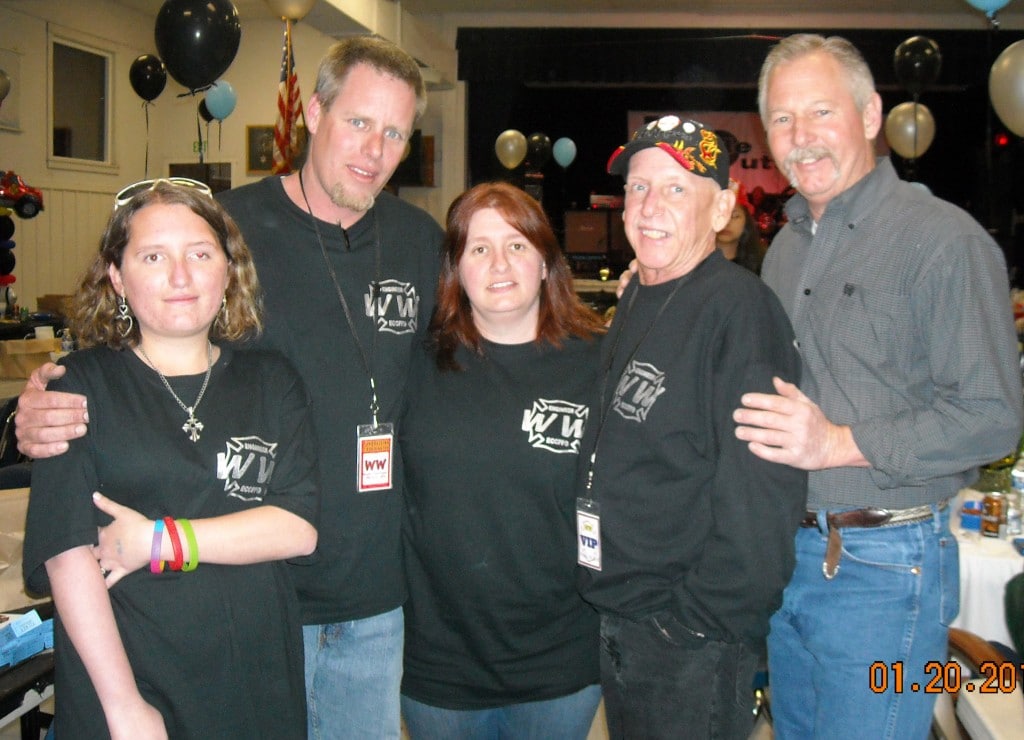 From Left to Right: Kendra, Mark, Jessica, Willy and Bill. Mark, Willy and Bill all responded to the accident.
From Left to Right: Kendra, Mark, Jessica, Willy and Bill. Mark, Willy and Bill all responded to the accident.
Name: Marilyn M.
Profession: Educator
Nominated by: Kendra N.
Marilyn has dedicated more than 40 years of her life to Education. She got her start in the early 70’s, teaching deaf and blind students in one of the first programs developed specifically for these children. Marilyn then moved to a small Alaskan village to teach Special Education. For years, she traveled around Alaska evaluating and writing programs for severely handicapped children and teaching Special Education and Kindergarten. After 30 years of teaching, Marilyn retired to Oregon and began working as a Reading Teacher. Motivated by her own struggles as a young student, she has a passion for helping students learn to read and write. Her successful reading program has helped countless young students over the course of her career. Marilyn retired from teaching in 2002, but continued to pursue her passion for education by working as a teacher’s aide, reading assistant and librarian. She is still actively working and volunteering in the Oregon school system, where ‘her excellence in teaching and working with young kids has always been apparent to the kids, the parents, other staff, and administration.’
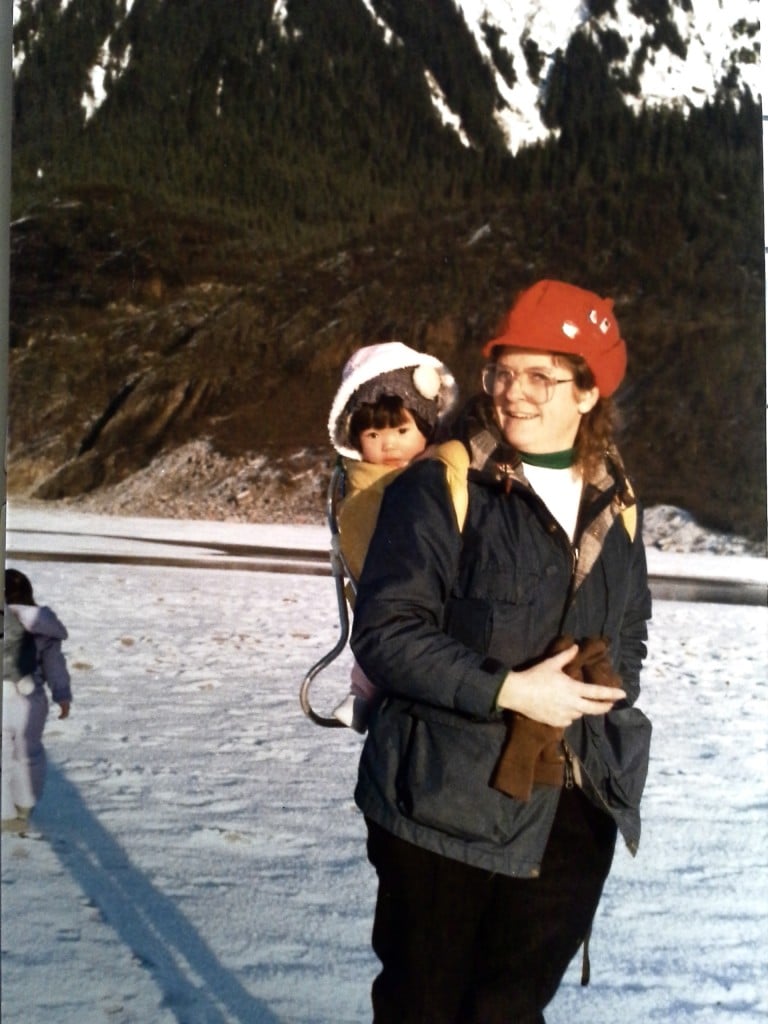 Marilyn and one of her students in Alaska in the 1980’s
Marilyn and one of her students in Alaska in the 1980’s
Name: John B.
Profession: Firefighter & Paramedic
Nominated by: Lori B., his wife
The son of a Chief of Police and Registered Nurse, John knew he wanted to be a Fireman at age 2. John started his Firefighting career roughly 38 years ago and launched his nonprofit, Firefighters for Fun, just 8 years later. He now travels the country educating children with his fire truck and ambulance classrooms, passing out extensive resources and spreading his ‘If you can be Heard, you can be Rescued’ motto. The life-saving potential of John’s mission was proved just a few weeks ago, when a wheelchair-bound man was saved from a dangerous house fire after his neighbors were able to find and rescue him thanks to a whistle John had given the man just months earlier. John uses all his spare time, including vacations, raising money for Firefighters for Fun, even converting another old fire truck into a mobile restaurant serving up food and fire knowledge at state fairs to help raise funds.
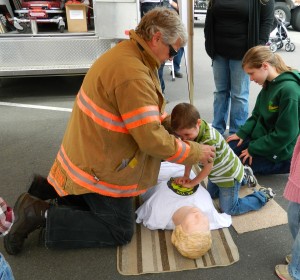 John teaching children CPR using his HOTS (Helping Others to Survive) Ambulance Classroom
John teaching children CPR using his HOTS (Helping Others to Survive) Ambulance Classroom
by California Casualty | Nurses |
It was almost nine o’clock on Sunday morning and Joyce DeZutti was running late. Along with her daughters Giovanna and Antoinette and her friend Andrea Skillman, Joyce had just enjoyed a weekend of pampering at the spa and was headed back to the airport. Suddenly, her limo slowed and swung out to the side, veering out of the way to drive around a car accident. Out the window, the women saw two vehicles, one looking banged up and the other flipped over completely. Joyce turned to her daughter and asked if she’d seen an ambulance at the scene. As Giovanna responded that she had not, Joyce immediately yelled, “Stop now!” to the limo driver, lunging toward the partition to get his attention.
“There was no way that limo was going by that accident,” says DeZutti. “Even if I had to go through that partition, we were stopping. There was no question. We were supposed to be there.”
A series of very fateful events brought Joyce DeZutti to that Hershey highway that morning. Joyce, a psychiatric nurse at Linden Oaks Hospital, was more than 700 miles away from where she lives and works in Naperville, Illinois. About two months earlier, she was randomly picked out of more than 6,700 entrants as the winner of the California Casualty ‘Give a Nurse a Break Getaway.’ The grand prize was a two-day trip to the Hershey Hotel and Spa in Pennsylvania, a relaxing reward and much-deserved break from the daily grind of nursing. That morning, Joyce was headed back to the airport after a weekend of pampering and relaxation. If things had gone according to plan, Joyce would have missed the accident altogether.
“We wanted to get an early start. So we were really trying to leave. But my friend Andrea does Florence Nightingale presentations and she had her full costume with her and wanted to have pictures taken before we left,” remembers DeZutti. “So we got the pictures and got delayed by quite a bit. By the time we got in the limo, we had been rushed a bit and I was a little upset.”
As it turns out, Joyce DeZutti was exactly where she needed to be at exactly the right time. First responders had yet to arrive at the scene when the limo pulled up to the accident. Joyce, who was supposed to be getting a break from nursing life, suddenly felt herself thrust right back into the action.
“I threw my purse at my older daughter and said, ‘Get my kit out.’ And I ran to the scene, hollering out ‘I’m a nurse and my friend is too,’” says Joyce. After double-checking that someone had already called 911, she ran over to the flipped car. “I could see there was a woman hanging upside-down by her seatbelt. She was awake. I talked to her and said, ‘I’m Joyce and I’m a nurse.’”
The driver, an elderly woman, told Joyce she was having trouble breathing. The car smashed in around her and glass littering the asphalt, her seatbelt and coat making it difficult to breathe. So Joyce crawled in beside her.
“I had no problem getting in to her. I was laying on the ground next to the car with my hand reaching to her. She said she couldn’t breathe, which was no surprise with the angle her head was at,” recalls Joyce. “She had a big, heavy down pink coat, so I unzipped that and pulled her clothes away from her neck and put my hand on her chest and lifted up so she could lift her chin and she could breathe. I held her like that and just talked to her, holding her hand.”
While Joyce was worried about the patient, her daughter Giovanna was standing nearby worrying about her mother. Joyce had severely injured her arms while working with the horses she uses as therapy for her patients. Surgeries over the years had left pins and plates in her arms.
“I knew she could get hurt, too,” says Giovanna. “I have no doubt that if my mom didn’t have this problem with her arm, she could do it just fine because she’s a strong lady- mentally and physically. But I was concerned about her hurting herself and her being home and being in a lot of pain.”
But the adrenaline kept Joyce’s attention away from her own pain and focused on the patient. The woman asked Joyce to call her niece and asked if anyone else was hurt. As Joyce’s daughter Giovanna called the victim’s niece, firemen arrived at the scene. Meanwhile, Skillman, who works as nurse at the VA, explained to Joyce what was unfolding around her.
“It was like a Code Blue situation. Everyone has a job. I look back at what Joyce and I ended up doing, and it was sort of the same thing,” says Skillman. “She was doing the direct care and I was scoping out of the area and letting her know what the firemen were doing.”
A firefighter took Joyce’s place supporting the woman and Joyce slipped back out of the mangled car. But she wasn’t leaving.
“I said ‘I’m going to stay until they get her out of there,’’ remembers DeZutti. “I couldn’t leave not knowing. So I stayed.”
As firefighters used the “Jaws of Life” to cut away the passenger side of the car, a man in his fifties or sixties walked up to Andrea.
“He hands me a card of phone numbers to call and I grabbed the card, thinking they must be the patient’s phone numbers. He said they were and walked away,” says Skillman.
The man was the driver’s son. At the time, no one realized he had actually been in the car at the time of the accident.
“I asked if that was his mother and he said yes and that he was in there. He told me he had a seatbelt on. And a bystander confirmed he had helped get the man out of the car,” says DeZutti. So she went back into nurse mode. “I started talking to him really gently and I told him I was a nurse and wanted to check him. I did a head-to-toe and didn’t find anything tender and everything seemed fine.”
Firefighters put both occupants of the rolled car, the woman and her son, in C-collars on backboards and loaded them into the ambulance. But not before Joyce offered her final words of comfort.
“Joyce said she wanted to talk to her now that she was out of the car,” says Skillman. “But this patient was what my husband, a fireman, calls a ‘load and go.’ You don’t stick around. You put them in the ambulance and take off.”
So Joyce seized her moment, captured in this picture…
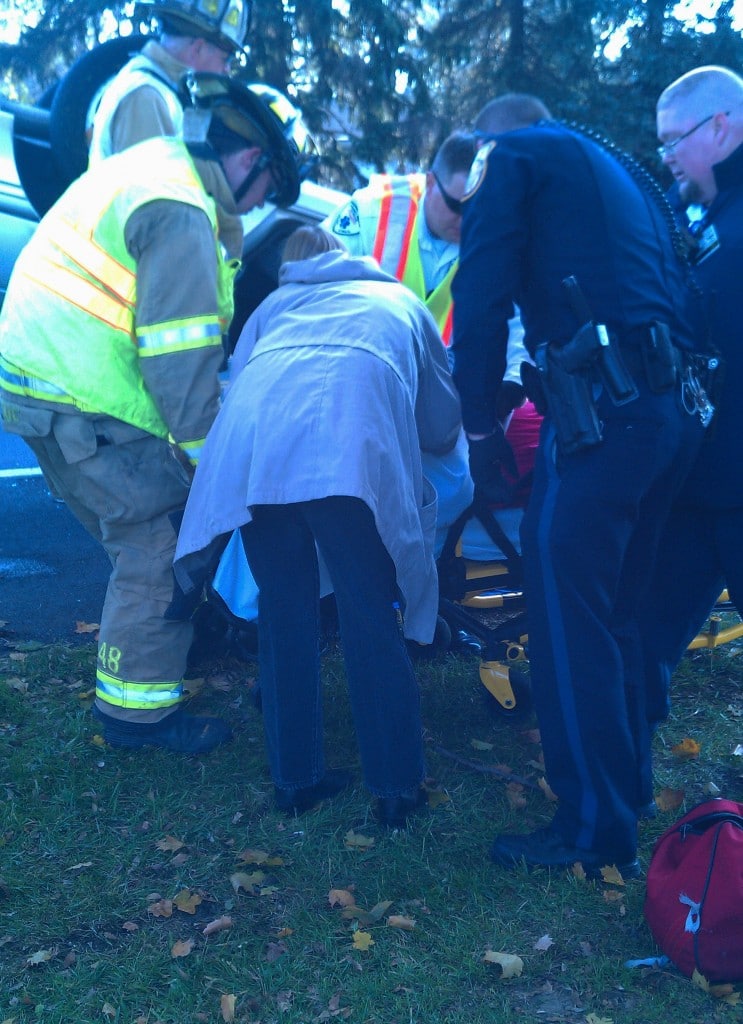 Photo Courtesy of Giovanna DeZutti, 2012
Photo Courtesy of Giovanna DeZutti, 2012
“I went to her and told her that her son was okay and that he was going to the hospital also to be checked over,” says DeZutti. “I said we had left messages with her family of where she was going to be.”
Joyce was the perfect person to pull up to the scene. A nurse for more than 30 years, she put herself through school by teaching taught EMTs and worked in a Trauma 1 Center and ICU. But to her daughter, Giovanna, up until that day she’d just been Mom.
“I’ve never seen my mom like that. My mom is my mom. My mom’s not a nurse to me,” says Giovanna. “But it was exciting watching her do it, because I’d never seen her doing anything like that. I’d seen maybe a call or two for a patient who was out of control, but this was totally different. It was a ‘bringing her back to the Emergency Room’ type of thing. She knew exactly what to do and what she was going to do ahead of time if this wasn’t working or that wasn’t working. It all came to her so fast. I could never do that. It was amazing. I see her more of a hero, now that I’ve seen her in action.”
But for Joyce, heroic action like this is the norm. This isn’t even the first time she’s stepped in to help an accident victim. When her kids were young, Joyce stopped to help another woman who was trapped upside-down in a rolled vehicle. She once witnessed a police officer get struck by a vehicle while directing traffic. She stopped to help him, too.
This story says something about nurses. We can try to give them a ‘break’ from their jobs. But stepping in and taking action to save lives is not just a part of their jobs. It’s a part of who they are.
Here’s where we need your help. When Joyce told us her story, we told her we would help her find out what happened to the woman and her son. But without knowing even the woman’s full name, although we believe her first name might be Jane, we’ve been unable to find her and check on her. If you know anyone in Pennsylvania, please pass Joyce’s story along and help us help this hero. After all, we figure it’s the least we can do to say ‘Thank You’ to this heroic nurse, Joyce DeZutti.
Do YOU know a Nurse, Firefighter, EMT, Peace Officer, or Educator Hero? Tell us about them!
To learn more about the Give a Nurse a Break Giveaway, click here.
Pictures from the Accident, The Hershey Spa, and the women in Washington D.C.:
All photos courtesy of Andrea Skillman and Giovanna DeZutti, 2012.
by California Casualty | Educators, Firefighters, Nominate a Hero, Nurses, Peace Officers |
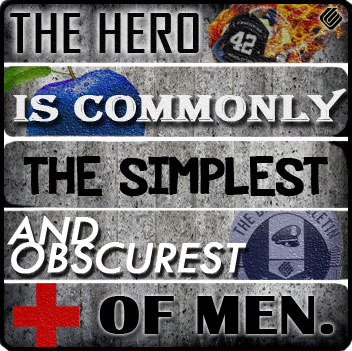
 Keith Carlson, or Nurse Keith as he’s known to his blog community, has been in the nursing field since 1996. Keith runs a Nursing Blog called Digital Doorway. A Registered Nurse and Certified Professional Coach, Keith says he has equal passion for both, which he uses “to help nurses live the most healthy, balanced and satisfying lives possible.” When Keith isn’t busy nursing, coaching and blogging, he’s working on “RN.FM Radio: Nursing Unleashed.” Keith co-founded the station, which strives to be “a place where nursing thought leaders, entrepreneurs, writers, bloggers and gifted clinicians can make their voices heard.”
Keith Carlson, or Nurse Keith as he’s known to his blog community, has been in the nursing field since 1996. Keith runs a Nursing Blog called Digital Doorway. A Registered Nurse and Certified Professional Coach, Keith says he has equal passion for both, which he uses “to help nurses live the most healthy, balanced and satisfying lives possible.” When Keith isn’t busy nursing, coaching and blogging, he’s working on “RN.FM Radio: Nursing Unleashed.” Keith co-founded the station, which strives to be “a place where nursing thought leaders, entrepreneurs, writers, bloggers and gifted clinicians can make their voices heard.”










